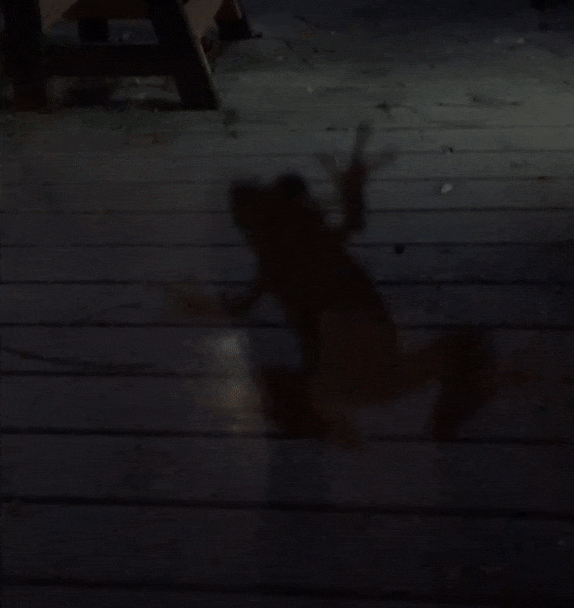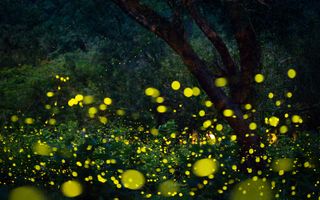Watch This Frog Light Up After It Swallows a Firefly

Cellphone video recently captured an incredible sight: After a tiny frog gulped down a firefly, the unlucky insect kept flashing from inside the amphibian's gullet, perhaps broadcasting a final, desperate SOS.
The frog, which was clinging to a window in Tallahassee, Florida, swallowed the firefly on June 11 at dusk, according to Beverly McCord, who told Live Science that she observed the moment in her backyard and quickly grabbed her phone to record it.
After swallowing the glowing insect, the frog appeared unharmed. That's surprising, as many firefly species secrete a chemical that is highly toxic to most predators, experts told Live Science. [Gallery: Eye-Catching Bioluminescent Wonders]
McCord told Live Science in an email that frogs like this one — possibly an American green tree frog (Hyla cinerea) — are a common sight in her yard, where nearly every night, at least one attaches itself to the glass on her doors or windows to catch the flying insects drawn to the light indoors.
"I was standing right there when the frog ate the firefly, and I was just kind of shocked when I saw it blinking inside him," McCord said. "It continued to stay lit for 10 to 15 minutes after being swallowed, steadily dimming during that time."
Generating the glow
Fireflies produce their signature glow — a process known as bioluminescence — in light organs located in their abdomens. These organs hold a chemical called luciferin, an enzyme known as luciferase and the energy-carrying molecule adenosine triphosphate. As fireflies introduce oxygen into the mix, it triggers a chemical reaction that produces light.
When firefly abdomens light up, the insects are signaling prospective mates with certain patterns that are specific to their species. However, the light show serves another important purpose: sending a warning to hungry predators that fireflies are too toxic to eat, Sara Lewis, a professor of evolutionary and behavioral ecology at Tufts University, told Live Science.
Sign up for the Live Science daily newsletter now
Get the world’s most fascinating discoveries delivered straight to your inbox.
"We're pretty sure from reconstructing the firefly phylogeny [evolutionary history] that firefly light first evolved as a warning signal, and it was educating predators about these chemical defenses," said Lewis, who authored the book "Silent Sparks: The Wondrous World of Fireflies" (Princeton University Press, 2016).

Look, but don't taste
There are around 2,000 species of fireflies, and most North American fireflies produce defensive steroids called lucibufagins, which are highly toxic to most predators with backbones, such as birds, reptiles and amphibians, Lewis said. Lucibufagins bind to a receptor embedded in the cell wall called the sodium pump, which is responsible for pumping electrically charged ions in and out. These steroids belongs to the same class of chemicals as digitalis, a drug used to treat congestive heart failure. In small doses, these compounds can stimulate the heart, but in large doses, they can paralyze heart muscles, Lewis said.
In fact, healthy pet lizards have developed lethal "firefly toxicosis" — firefly poisoning — after eating fireflies, according to a study published in September 1999 in the Journal of Chemical Ecology. In one case, within an hour after a bearded dragon in the Pogona genus ate a single firefly, it began gaping its jaws and biting its tongue. It continued gaping as its skin color changed from tan to black, and 2 hours later, it was dead, the study authors reported.
Fireflies "reflex bleed" this toxin through their joints when they're under stress, Mark Branham, an associate professor in the Department of Entomology and Nematology at the University of Florida, told Live Science. Even humans can be affected by this powerful poison — as Branham himself unexpectedly discovered firsthand. [Top 10 Deadliest Animals (Photos)]
A firefly in the mouth
About two decades ago, Branham was collecting fireflies in a field, and he gently placed one between his lips to free up his hands while opening a vial — but he wasn't gentle enough for the firefly, which swiftly deployed its chemical weapon.
"I was really surprised at how fast my lips started tingling and then went numb, and my throat started to feel a little bit constricted," he said. The effect lasted about 30 minutes, Branham recalled.
But if firefly toxin is so potent, how was the Florida frog able to eat the firefly, and apparently suffer no ill effects? One possibility is that the firefly belonged to a species that doesn't produce toxins, Lewis suggested.
"Or maybe that particular tree frog is one of the predators that is somehow immune to the firefly toxins," she said.
And even among fireflies that generate chemical defenses, the amount of toxins they produce or how much of it they transfer to the outside of their bodies can vary among individuals — and perhaps the frog just got lucky, Branham said.
Then again, maybe it didn't. Because the frog had very recently eaten the firefly when the footage was captured, it's also possible that the effects of the toxins hadn't had enough time to do any real damage, Nick Caruso, an ecologist at the Virginia Polytechnic Institute and State University, told Live Science in an email.
"Likely if we followed that frog for an hour or so, we might see a different story," Caruso said.
Whether the frog ultimately survived the encounter and will continue to devour fireflies is anyone's guess. But Branham's one experience with a mouthful of firefly definitely ensured that it would be his last, he told Live Science.
"I certainly wouldn't put them in my mouth again," Branham said.
Original article on Live Science.

Mindy Weisberger is an editor at Scholastic and a former Live Science channel editor and senior writer. She has reported on general science, covering climate change, paleontology, biology and space. Mindy studied film at Columbia University; prior to Live Science she produced, wrote and directed media for the American Museum of Natural History in New York City. Her videos about dinosaurs, astrophysics, biodiversity and evolution appear in museums and science centers worldwide, earning awards such as the CINE Golden Eagle and the Communicator Award of Excellence. Her writing has also appeared in Scientific American, The Washington Post and How It Works Magazine. Her book "Rise of the Zombie Bugs: The Surprising Science of Parasitic Mind Control" will be published in spring 2025 by Johns Hopkins University Press.
Most Popular




